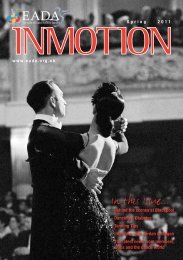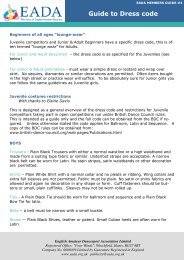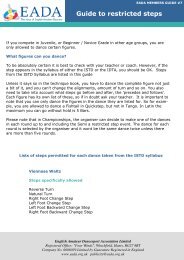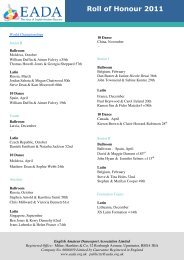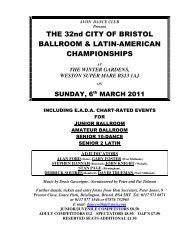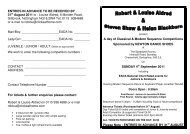In this Issue... - EADA
In this Issue... - EADA
In this Issue... - EADA
You also want an ePaper? Increase the reach of your titles
YUMPU automatically turns print PDFs into web optimized ePapers that Google loves.
A pain in the neck? Hyperextension Neck <strong>In</strong>jury inFemale Ballroom Dancersby Teri Riding McCabe, MS, ATC+44 (0)20 8664 8188I have been researching the causeof the neck injury that occurs tofemale ballroom dancers when theylose control of their necks whiledancing and competing. I called it a“hyperextension neck injury” (HNI)and defined <strong>this</strong> as “the temporaryinability to hold the neck in correctdance position”. The overall aim ofmy research is to possibly identifyone or many causes of <strong>this</strong> HNI.I want to say thank you to everyonewho has participated in my researchand give an update on my findingsso far.Last year I did an online survey with femaleballroom dancers and found that 25% of theparticipants had the HNI and that dancers of ayounger age were more likely to have HNI than theolder dancers. The dancers were also more likelyto suffer from HNI at competitions, rather than atperformances, lessons, or practices.Recently I travelled across England, visiting dancestudios, to measure male ballroom dancers to seeif their hand placement could be a cause of HNI.The male partner typically places the right handaround his female partner’s body to the inferiorangle (IA) of the scapular bone. I found that 65%of the participants placed their right hand belowand 35% placed it above the IA. On average thehand was placed either 4.1 ± 2.6 cm below or2.8 ± 1.3 cm above the IA. I also measured thecircumference of the forearm and upper arm(biceps and triceps) and found those dancers whoplaced their hands below the IA were statisticallymore likely to have a larger circumference thanthose above.So what does <strong>this</strong> mean to you? If you are ayounger female ballroom dancer, keep practisinggood technique, strengthen your neck muscles,and don’t forget to eat nutritious meals before andduring competitions. If you are a male ballroomdancer, keep practising good technique and be agood partner!To find out more information see Teri’sfacebook page: www.facebook.com/pages/Teri-Ridings-PhD-Research-on-Ballroom-Dancers/105913372790317Teri Riding McCabe is a Certified Athletic Trainerin the United States. She graduated from BrighamYoung University in Provo, Utah with BS and MSdegrees in Athletic Training. She is currently aPhD student at the University of Wolverhampton,Walsall Campus studying the HNI in femaleballroom dancers.This article first appeared in Dance Todaymagazine in May 2012:www.dance-today.co.uk12




